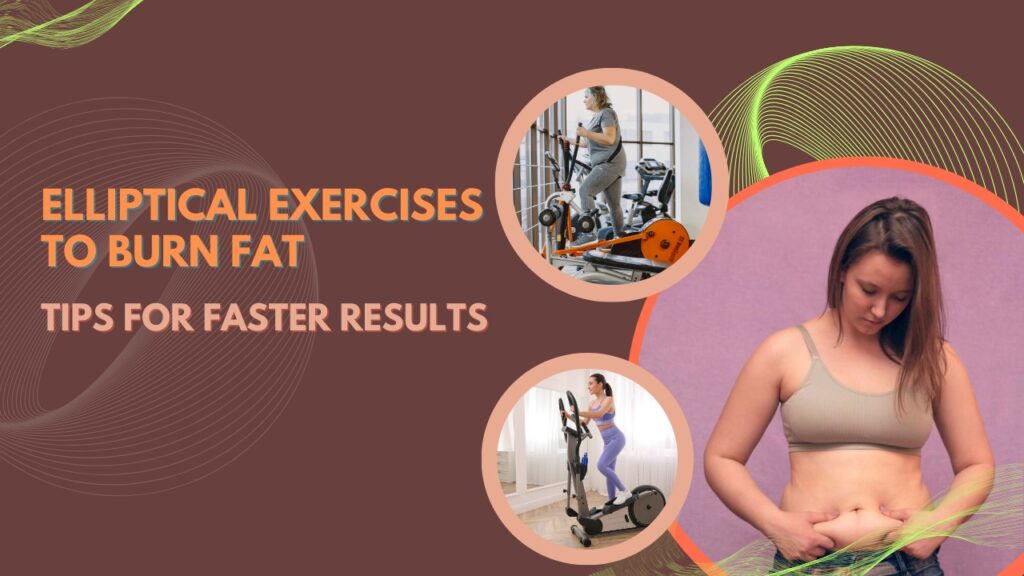Elliptical exercises to burn fat are a highly effective yet often underestimated option for fitness enthusiasts. While treadmills and intense HIIT classes steal the spotlight, the elliptical provides a powerful, low-impact way to torch calories and shed excess weight. By engaging both the upper and lower body simultaneously, you activate more muscle groups, leading to higher energy expenditure and improved fat loss.
One of the biggest advantages of elliptical exercises to burn fat is their joint-friendly nature. The smooth, gliding motion significantly reduces the risk of impact-related injuries, making it ideal for people with knee, hip, or back concerns. This allows you to train longer and more consistently without the discomfort often associated with high-impact cardio.
Additionally, elliptical training can be tailored for both steady-state cardio and interval workouts, helping boost cardiovascular endurance while toning muscles. By adjusting resistance and incline, you can continuously challenge your body and accelerate fat-burning results.

Whether you’re new to the gym or a seasoned fitness enthusiast, learning how to maximize your time on the elliptical can help torch calories, shred fat, and improve your overall health. This article dives deep into the top 8 tips for using the elliptical to burn fat, how it compares to other forms of cardio, and how to build a sustainable fat-loss routine with this low-impact powerhouse.
Why the Elliptical is Effective for Fat Loss
Elliptical exercises to burn fat are effective because they combine cardiovascular training with full-body muscle engagement. Unlike some cardio machines that focus mainly on the lower body, the elliptical works your arms, core, and legs together, increasing calorie burn and boosting overall workout efficiency. This combination helps accelerate fat loss while also improving muscle tone.
Another reason elliptical exercises to burn fat are so powerful is their low-impact design. The smooth, gliding motion minimizes strain on your joints, making it easier to maintain a consistent workout routine without the setbacks of injury or soreness. Consistency is key to fat loss, and the elliptical supports long-term training.
Finally, the versatility of the elliptical allows you to adjust resistance, incline, and speed for both steady-state and interval training. This flexibility keeps workouts challenging, prevents plateaus, and maximizes fat-burning potential for faster, sustainable results.
Elliptical machines combine the motions of running, climbing, and cycling in a smooth, joint-friendly way. Here’s why they’re perfect for fat-burning:
Low-impact: Ideal for people with knee, hip, or back issues.
Full-body workout: Targets legs, glutes, core, chest, back, and arms when using handlebars.
Customizable resistance and incline: Allows you to tailor workouts to your fitness level and fat-loss goals.
Calorie burning: You can burn between 250–600+ calories in just 30 minutes depending on intensity and weight.
Top Tips for Burning Fat with Elliptical Workouts
Use Interval Training (HIIT on Elliptical)
Using interval training is one of the most effective ways to make elliptical exercises to burn fat work faster. By alternating between short bursts of high intensity and periods of active recovery, you keep your heart rate elevated and your metabolism working hard even after the workout. This “afterburn” effect means your body continues burning calories long after you step off the machine.
For HIIT on the elliptical, try increasing resistance and incline for 20–30 seconds of maximum effort, then slow down for 60–90 seconds at an easier pace. This method challenges your cardiovascular system and engages more muscles, leading to better fat-burning results in less time.
Elliptical exercises to burn fat using interval training also make workouts more dynamic and enjoyable. The constant changes in speed and resistance push you past comfort zones, break through plateaus, and help you achieve faster, more sustainable fitness goals.
High-intensity interval training (HIIT) is one of the most efficient ways to burn fat. It involves alternating between short bursts of intense effort and recovery periods.
How to do it:
Warm-up for 5 minutes at a moderate pace.
Sprint for 30 seconds at high resistance and fast RPM (90–100).
Recover for 90 seconds at low resistance and a slower pace.
Repeat this cycle 6–10 times.
Cool down for 5 minutes.
Increase Resistance and Incline
Increasing resistance and incline is a powerful way to maximize the benefits of elliptical exercises to burn fat. Higher resistance forces your muscles to work harder, particularly in your legs, glutes, and core, which increases calorie expenditure and promotes lean muscle development. Building more muscle helps your body burn fat more efficiently, even at rest.
Adjusting the incline changes the angle of your workout, targeting different muscle groups and adding variety to your routine. A steeper incline emphasizes your glutes and hamstrings, while moderate settings work your quads and calves. This variation keeps your muscles challenged and prevents your body from adapting too quickly.
Elliptical exercises to burn fat become far more effective when you gradually increase resistance and incline over time. This progressive overload ensures continuous improvement, boosts endurance, and intensifies calorie burn, helping you achieve faster and more noticeable fat-loss results without excessive joint stress.
Don’t just glide through your workout. To burn fat effectively, increase the resistance and incline to simulate uphill climbing. This not only engages more muscle groups but also boosts calorie expenditure.
Fat-burning tip: Start at a moderate resistance and every 5 minutes, bump it up by 1 level. Try combining it with an increased incline for more challenge.
Benefits:
Builds muscle (especially glutes and thighs)
Increases heart rate
Makes your body work harder
Focus on Full-Body Movement

Focusing on full-body movement can significantly enhance the effectiveness of elliptical exercises to burn fat. Many people rely only on their legs, but using the handlebars to engage your arms activates your upper body muscles, including your biceps, triceps, shoulders, and chest. This extra engagement increases calorie burn and promotes balanced muscle development.
Coordinating both upper and lower body movements also challenges your core. Your abdominal and lower back muscles work to stabilize your body during the motion, helping to tone your midsection while improving posture. This added core activation further boosts the overall fat-burning potential of your workout.
When performing elliptical exercises to burn fat, maintain an upright posture, push and pull the handlebars with purpose, and match your arm movements with your leg stride. This full-body approach turns a simple cardio session into a total-body calorie-burning workout, delivering faster and more sustainable results.
Many people ignore the moving handlebars and just use their legs. That’s a mistake if your goal is fat loss.
To maximize calorie burn:
Engage your core throughout the session.
Push and pull the handlebars to involve your upper body.
Keep your back straight and shoulders relaxed.
Monitor Heart Rate Zones
Monitoring your heart rate zones is a smart way to make elliptical exercises to burn fat more efficient. By staying within the optimal fat-burning or cardio zone, you ensure your body is working at the right intensity to burn calories effectively without overtraining. For most people, the fat-burning zone is around 60–70% of their maximum heart rate, while the cardio zone is about 70–85%.
Using the heart rate monitor on your elliptical helps you track your effort in real time. This allows you to adjust resistance, incline, or speed to stay within your target zone, whether you’re doing steady-state cardio or intervals. Consistent monitoring keeps your workouts focused and productive.
When doing elliptical exercises to burn fat, maintaining the right heart rate balance helps maximize energy use, improve endurance, and prevent burnout. It’s a simple but powerful tool to ensure each workout brings you closer to your fat-loss goals.
Fat burning is most efficient when you’re training in the right heart rate zone. For most people, the fat-burning zone is around 60–70% of your max heart rate.
How to calculate max heart rate:
220 – your age = Max HR
Example: If you’re 30, your max heart rate is 190.
Fat-burning zone: ~114–133 bpm.
Try Reverse Pedaling (Backward Motion)

Reverse pedaling is an underrated way to make elliptical exercises to burn fat more effective. Moving backward shifts the focus from your quads to your hamstrings, glutes, and calves, engaging different muscle groups that aren’t worked as intensely during forward motion. This change not only boosts calorie burn but also promotes balanced lower-body strength.
The backward motion also challenges your coordination and balance, which activates your core muscles. As your body adjusts to the reverse stride, you recruit more stabilizing muscles, increasing the overall intensity of your workout without needing to increase speed or resistance drastically.
Adding reverse pedaling to elliptical exercises to burn fat keeps your routine fresh and helps avoid workout plateaus. Try alternating between forward and backward motion every few minutes to target more muscles, enhance endurance, and keep your body guessing for maximum fat-burning results.
Why it works:
Engages different muscle groups (especially hamstrings and calves)
Prevents muscle adaptation and plateaus
Increases the challenge for coordination and core strength
How to do it:
Pedal backward for 1–2 minutes every 5 minutes.
Increase resistance slightly while in reverse.
Incorporate Steady-State Cardio Days
Steady-state cardio days are an excellent way to make elliptical exercises to burn fat more sustainable and balanced. This method involves maintaining a consistent pace and moderate intensity for an extended period, typically 30–60 minutes. It helps improve cardiovascular endurance while steadily burning calories without overtaxing your body.
By keeping your heart rate in the fat-burning zone—around 60–70% of your maximum—you allow your body to use stored fat as a primary energy source. Unlike high-intensity sessions, steady-state cardio is easier to maintain regularly, supporting long-term fat-loss goals while reducing the risk of burnout.
Including steady-state cardio in your elliptical exercises to burn fat also aids in recovery from more intense workouts. The consistent motion improves blood flow, reduces muscle soreness, and helps you stay active even on lower-energy days, ensuring your fitness routine remains consistent and effective over time.
While HIIT is effective, steady-state cardio also has a place in fat loss.
What it is: Exercising at a consistent pace (moderate intensity) for 30–60 minutes.
Benefits:
Burns calories over a longer period
Easier on recovery days
Builds aerobic endurance
Mix It Up With Programs and Workouts

Using different programs and workouts is a smart way to make elliptical exercises to burn fat more engaging and effective. Many ellipticals come with built-in routines that vary resistance, incline, and speed, helping you challenge your muscles in new ways and avoid workout plateaus. Changing your approach regularly keeps both your body and mind stimulated.
Experimenting with different workout styles—such as hill climbs, endurance sessions, or sprint intervals—targets various muscle groups and energy systems. This variety boosts calorie burn, improves cardiovascular health, and develops strength in areas that might be overlooked with repetitive routines.
When you mix up your elliptical exercises to burn fat, you prevent your body from adapting too quickly, which helps maintain steady progress. It also makes your workouts more enjoyable, increasing the likelihood that you’ll stick to your routine and continue seeing results over the long term.
Most modern elliptical machines have built-in programs like fat burn, hill climb, interval, and cross-trainer modes. Use them!
Why this helps:
Prevents boredom
Keeps your muscles guessing
Challenges different energy systems
Makes workouts more enjoyable
Fat-burning combo idea:
Day 1: HIIT mode
Day 2: Cross-training mode
Day 3: Recovery ride
Day 4: Manual interval challenge
Stay Consistent & Combine with a Calorie Deficit
Staying consistent is the foundation of making elliptical exercises to burn fat truly effective. Regular workouts help you build endurance, improve muscle tone, and maintain a higher calorie burn over time. Sporadic training won’t deliver the same results as a steady, well-structured routine you can commit to long term.
Pairing your exercise with a calorie deficit is equally important. This means consuming slightly fewer calories than your body burns daily, encouraging it to use stored fat for energy. Without a proper diet, even the most intense workouts may not lead to noticeable fat loss.
When you consistently perform elliptical exercises to burn fat while maintaining a moderate calorie deficit, you create the perfect environment for sustainable weight loss. Over time, this combination not only helps you shed excess fat but also improves your overall fitness, health, and confidence.
Even the best elliptical workout won’t burn fat if your nutrition is off.
Combine elliptical exercises with:
A calorie-controlled diet (consume fewer calories than you burn)
Adequate protein intake to preserve muscle
Hydration and sleep
Sample 7-Day Elliptical Fat Loss Workout Plan
| Day | Workout Type | Duration | Intensity |
|---|---|---|---|
| Monday | HIIT Intervals | 30 mins | High |
| Tuesday | Steady-State | 45 mins | Moderate |
| Wednesday | Incline Climb | 30 mins | Moderate-High |
| Thursday | Recovery Glide | 30 mins | Low |
| Friday | Reverse Motion Intervals | 30 mins | Moderate |
| Saturday | Fat Burn Program | 60 mins | Moderate |
| Sunday | Rest or light walk | — | Low |
Benefits of Elliptical Workouts Beyond Fat Loss
Elliptical exercises to burn fat offer far more benefits than just weight loss. One of the biggest advantages is improved cardiovascular health. Regular sessions strengthen your heart and lungs, enhancing blood circulation and increasing stamina for both workouts and daily activities. This boost in endurance supports overall wellness and energy levels.
Another key benefit is joint-friendly training. The smooth, low-impact motion of the elliptical minimizes stress on knees, hips, and ankles, making it ideal for people recovering from injuries or those with chronic joint concerns. This allows for consistent training without the wear and tear caused by high-impact workouts.
Elliptical exercises to burn fat also help build and tone muscles, especially in the legs, glutes, arms, and core. By adjusting resistance and incline, you can focus on strength as well as endurance, creating a balanced fitness routine that improves posture, coordination, and overall physical performance.
Improves cardiovascular health
Reduces risk of joint injuries
Strengthens muscles without heavy weights
Boosts mental well-being and reduces stress
Improves coordination and balance
Conclusion

Elliptical exercises to burn fat provide an effective, low-impact solution for achieving lasting fitness results. They combine calorie-burning cardio with muscle-toning resistance, making them ideal for those who want to lose weight without straining their joints. This versatility allows for a wide range of training styles that suit different fitness levels.
Sticking to a consistent routine is essential for success. When paired with a healthy diet and a calorie deficit, elliptical workouts can lead to steady fat loss while improving endurance and strength. The ability to adjust resistance, incline, and pace ensures that your body continues to adapt and progress.
In the end, elliptical exercises to burn fat do more than just help you slim down—they also enhance heart health, build lean muscle, and boost overall energy. By committing to regular workouts, you’ll enjoy both the physical and mental rewards of a stronger, healthier lifestyle.
FAQs
Q1. Are elliptical exercises to burn fat as effective as running?
Yes. While running can burn slightly more calories per minute, elliptical workouts engage both upper and lower body muscles, making them highly effective for fat loss with less joint impact.
Q2. How long should I use the elliptical to burn fat?
Aim for at least 30–45 minutes, 4–5 times per week. Combining steady-state and interval training delivers the best results.
Q3. Can beginners start with elliptical exercises to burn fat?
Absolutely. The low-impact nature of the elliptical makes it ideal for beginners, allowing them to build endurance and strength gradually.
Q4. Should I use high resistance or high speed for fat loss?
A mix of both works best. Resistance builds muscle, while speed boosts calorie burn—together they maximize fat loss.
Q5. Do elliptical exercises to burn fat also tone muscles?
Yes. Resistance settings target legs, glutes, arms, and core, improving muscle tone alongside fat loss.
